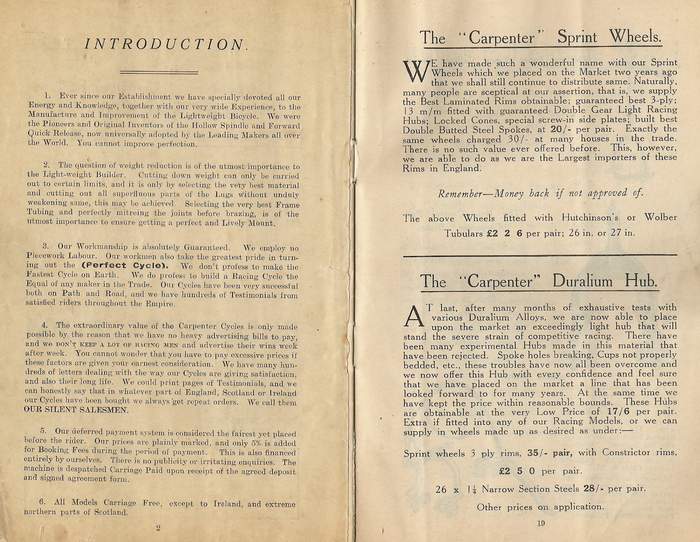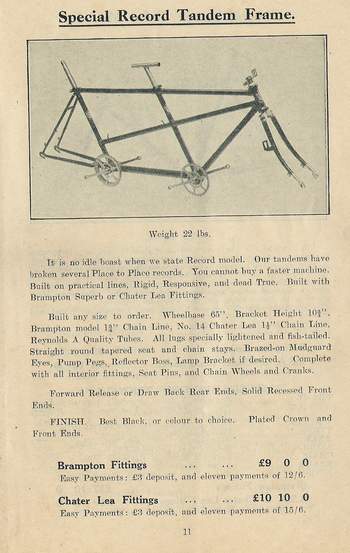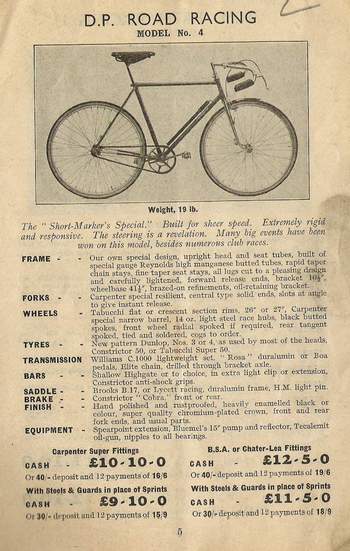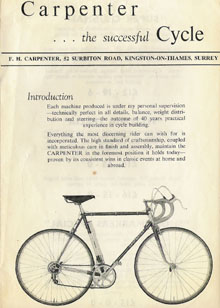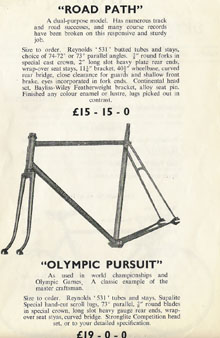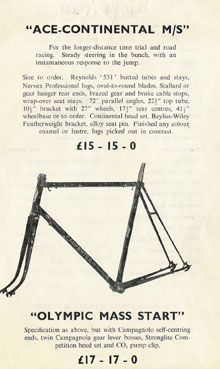Carpenter, F H
Posted: Tuesday 02nd June 2020
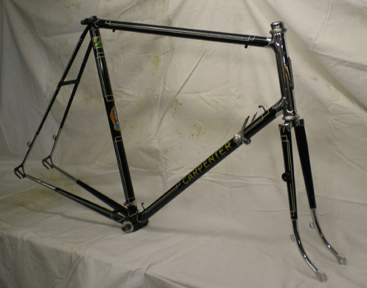
From the 1920s to the 70s
Carpenter cycles are acknowledged by connoisseurs as being one of the best of lightweight cycle frames. They always made orthodox frames of the highest quality and their elegant proportions, superb finish and fine workmanship established a reputation for quality and performance that many thought was not surpassed by any other frame builder.
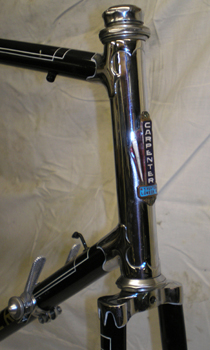
This black frame is a 1949 “one off “. History obscure but it surfaced at Herne Hill a few years ago – at that time it was totally original – CLB brakes, Allumite rims on LF Blumels with double-fixed ,Tour de France bars on GB stem, Brook B17 Swallow saddle, Williams C1000 crank etc. I know this because I saw the bike there myself and photographed it. Unfortunately, by the time I was offered the frame all the original parts had long gone. However, I have managed to find virtually all the correct parts for it (except the bars if you know of any available). I had the frame refinished to original specification and it should be on the road soon. The frame clearly illustrates Carpenters fine lug finishing and classic design.
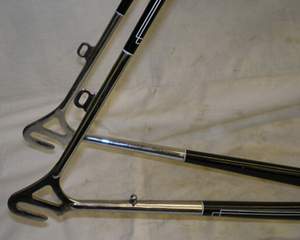
Established in the early 1920s ,the earliest catalogue available to the author, dated 1927, gives their address as H. Carpenter & Son, Head Office and Works, 43,Penton Street, London N.1. Certainly they had been trading for several years previous to this date – in 1925 they had introduced a range of imported sprint wheels. Located near “The Angel” of Islington, a locality that was becoming well known to lightweight cycle enthusiasts. Several of the famous “names” in frame building had their shops in this area of London at this time.
Even at this early period the range of Carpenter frames included two sporting tandems ,a “Special Record Tricycle”, two path frames and both gents and ladies sports models. Clearly they had already become involved in sporting events with some success. They were also innovators of some note having introduced the hollow spindle and the revolutionary forward quick release rear ends (see advert below) which were then adopted by other manufacturers.
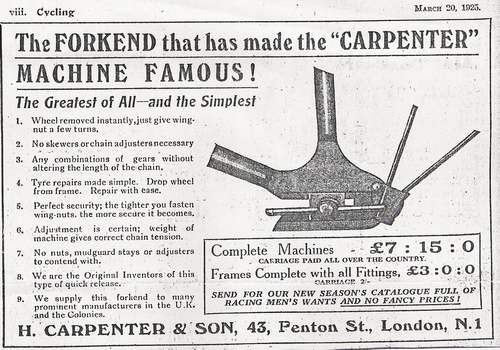
In 1929 they introduced a Duralium hub. In the early 1930s reference is made in the catalogues to “Reynolds high-manganese butted tubing” and in 1935 this is referred to as “Reynolds H.M. or 531 tubing”.
During W.W.II the bomb damage to the Islington area caused them to move from Penton Street, and at some period towards the end of the war they relocated to Kingston on Thames where they spent the rest of their life. The address became F.H.Carpenter, 52 Surbiton Road, Kingston-on-Thames, Surrey. They continued their business at this location throughout the ‘50 and ‘60s and had considerable success in competition events with riders such as Mike Gambrill, Robin Buchan and Jack Manning.
In the 1960s, F.H. Carpenter fell ill and had to retire from the business. For a short period Carpenter frames were manufactured under licence by Swindon Cycles of 90 Commercial road, Swindon who also built Colin Cape frames. It is thought that this business closed in the early 1970s.
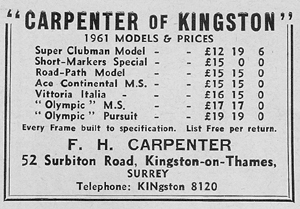
1945 – 1968
Left: Carpenter advert from Sporting Cyclist May 1961 showing range of models including Olympic M.S.
During the time they were based in Kingston the Carpenter shop became the centre of sporting cyclists in the area. Frank Carpenter was a leading figure in the Festival Road Club and the shop became its unofficial second clubroom. Frank was President of the Club for many years. The shop was well known for its friendly atmosphere and Mrs Carpenter ran the shop’s administration side and kept detailed records in her precise handwriting. She also ran a “book” for the younger riders which enabled them to buy equipment by spreading repayments over a period of time. Known by club members as “Mrs C”, she was liked and admired by all who dealt with the shop. Frank was regarded with some awe and respected for his fanatical attention to detail. He often offered advice and guidance to young riders and rode competitively in his younger days. However, he could be a little feisty if materials delivered to him or any sub-contracted work was not up to his high standards.
“I remember Frank Carpenter during the 1960/70s. Like most other artisan frame builders he worked on his frame building in a tiny workshop at the back of the shop in Surbiton Park Terrace, while his wife minded the shop!
His father had built racing motorcycle frames which were used by racers on the famous Brooklands circuit at Weybridge, a few miles away. He was a total perfectionist. At that time he did file his own lugs but mainly used Nervex Professional which were not good enough for him, so he spent hours filing each set so they were absolutely smooth and sharp. Frank was conservative, and not overkeen on adopting the heavier seat stays and ultra close clearances which came into fashion, preferring slim, elegant seat and chain stays. His perfectionist tendencies led him to examine each pair of Reynolds forks minutely, usually complaining how they were now made by machines and the blades no longer came in identical matching pairs!
Frank was also an ace wheel builder which set him apart from others. At this time we time-trialists wanted 7-ounce wood insert sprint rims, built with 24 or 28 spokes and fitted with 5 ounce tyres, we then rode them over potholed roads! Any defective wheel with a shake of more that about 5mm was declared, “trueable, but needs a new rim really!”
It is said that Frank supplied wheels to many leading competition cyclists of that time including Reg Harris.
Catalogue details:
Sporting Successes:
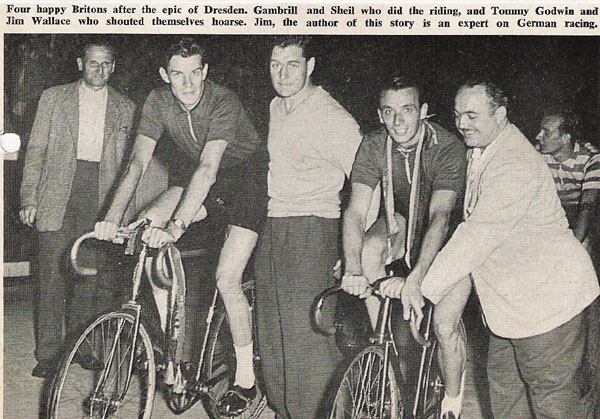
Some of the successful riders who used Carpenter frames:
Mike Gambrill
A well known rider of the 1950s and a member of the Clarence Wheelers. One of Mike’s best races was the “Epic Dresden Madison “ of 1959 in which he was paired with Norman Sheil .Fresh from their success of a few days earlier in Leipzig the pair faced stiff opposition from riders from Berlin and the local Dresden Matadors team. Mikes younger brother Robin was paired with Ken Craven. At half distance a new 20km track record time of 25min 31sec was set. The British pair took first place with 21points and a track record of 40km in 51.41.2 (29. 5mph). Mike rode a 26 inch Carpenter track frame in this event.
Jack Manning. (rode frame nos 4146 & 4215)
Notorious for racing anything anywhere Jack was a superb rider whose racing career was severely curtailed by the outbreak of WW 11 .He was the last man to win a cycle race at Brooklands on the Campbell circuit. He worked as a toolmaker with an aircraft company. After the war he took part in many top-class events using his Carpenter frames. He was invited to join the first Milk Race team but declined due to his wife’s concern about him attending the race.
Johnny Vaughan
During the period 1959 – 63 Johnny worked as a frame builder with Carpenters. He was also a keen competition cyclist and rode Time Trials during this period.
Freddie Smeeth (?)
Freddie worked at the Carpenter shop as wheel builder and mechanic
Harry Grey
Worked with H.Carpenter at the Penton Rd address as a frame builder , reputed to have slept in the shop cellar for a period when digs were not available.
Bill Inder (rode frame no 5279)
Bill, with two other founder members, had brought touring cycling to Woking in 1922 and by 1928 had formed the West Surrey D.A. A rider of no mean ability, who told tales of daily mileages of more than 100 miles whilst carrying camping kit on dreadnaught cycles, with 28 x 1.5″ wheels and tyres, in the early years. He became the President of the West Surrey D.A.in 1955 continuing in office until his death in 1992.
Jim Wheeler
Rode for the Festival Road Club .Won the Bath Road 100 in 1961 with a time of 4hr.2min.27sec.In the same year Jim together with the twin brothers John and Brian Froud won the National Championship 100 team award.
John Froud
Festival Road Club. Rode in the Tour of Britain , the Milk Race and the Peace race (Berlin –Warsaw – Prague)
Robin Buchan (rode frame no 4756)
Rode with the Norwood Paragon C.C. The 1960 Olympics saw Robin Buchan travel to Rome as reserve for the team pursuit and road team. He set a record for the 24hr Senior Mens class in 1971 covering 483.84 miles.
Frame Numbering:
Carpenter adopted a simple sequential numbering system for their frames. All numbers are stamped on the underneath of the bottom bracket and on the front fork tube. Examples:-
| Frame | Date | |
| 3511 | May 1st 1938 | verified by copy of original receipt |
| 4176 | Oct 10th 1947 | verified by copy of original receipt |
| 4532 | 8th August 1950 | verified by copy of original receipt |
| 5378 | 24th February 1962 | verified by copy of original receipt |
| 5473 | 4th April 1964 | verified by copy of original receipt |
The earliest Frame Number on the register is 3050 and the latest 5752 . It is reasonable to draw from the verified dates that Carpenters produced around 100 frames per year and this makes dating frames a relatively easy job. The marque enthusiast maintains a register of frames and their details and is happy to assist in dating frames for owners.
Contact:- JOHN GILL email – john.gill6(at)btinternet.com
The Marque Enthusiast would like to express his gratitude to the many people who have helped with information and reminisces of Carpenter cycles. In particular Mrs Valerie Walker, Keith Mitchell and Les Bowerman.
Additional by: Peter Underwood (written before the piece above was submitted)
As a teenager several riders from the nearby Wisbech Wheelers used to own Carpenter machines. For some reason I have always had a feeling for them although I don’t own one.
My first catalogue for information is obviously from the 30s with frames from £3 7s 6d. Carpenter are located at 43 Penton Street, London, N1 in this catalogue. Carpenter state that they are issuing this new catalogue introducing some new models which they list as follows:
| Clubman. | Model No. 1 | £3 7s 6d |
| Clubgirl. | Model No. 2 | £3 7s 6d |
| H M Super Clubman | Model No. 3 | £4 5s 0d |
| D P Road Racing | Model No. 4 | £4 12s 6d |
| H M Path Racing | Model No. 5 | £5 0s 0d |
| H M 'Supalite Special' | Model No. 6 | £5 12s 6d |
| De Luxe Touring | Model No. 7 | £3 10s 0d |
| 'Ace Continental' | Model No. 8 | £5 5s 0d |
Plus two tandems, Road Race and H M ‘Supalite Special’
All frames were supplied complete with head and bracket fittings, chainwheel and cranks, seat pin, etc. Usual brazed-on refinements. Enamelled to choice. Chromium front and rear ends. There was an extra charge for BSA or Chater Lea fittings.
Gears offered were: Cyclo 3-speed; TriVelox; Osgear; Conloy;Simplex Super or Professional models.
Witney 2-speed; Villiers; Cyclo.
Sturmey 3-speed also available with brake or as close or medium ratio.
All frames jig-built ensuring absolute accuracy. Tubes are mitred and pinned into special angled lugs superbly filed and lightened. We have lugs of all angles and do not resort to the dangerous practice of lug pulling. (My italics)
My next brochure seems to be from the 50s and at this time they were located at 52 Surbiton Road, Kingston-on-Thames and I believe there was a shop with this name until a few years ago. However like many shops it dealt mainly in mountain bikes in later years. This catalogue has an introduction which states each machine produced is under my (F H Carpenter) personal supervision, technically perfect in all details, balance, weight, distribution and steering. This they say is the outcome of over 30 years practical experience in cycle building. This would put their launch date at sometime in the 1920s.
By now the number of models is down to four, the frame prices are ‘Path’ Model £16 0s 0d; ‘Ace’ Continental £14 10s 0d; B.A.R. Road Racing £13 15s 0d and the ‘Super Clubman’ at £13 10s 0d.
As an aside, an iteresting piece in this catalogue offers head fittings as, ‘head clip’ or ‘colonial’. I guess that ‘colonial’ would be an expander-bolt fitting but I have never heard it called this before.
The ‘Path’ model is offered to a very hich specification as a complete machine with 75° head and 72° seat, all round forks with double plate crown, alloy or wood sprints on Airlites, Chater chainset with block chain (when available), Merkins or Major Taylor stem and Brooks B17 Sprinter saddle. This specification is a s good as it got in those days.
The ‘Ace Continental’ was offered with either 73° x 71° or 72° x 70° angles whereas 72° parallel was very popular in those days. All of these angles are recommended specifications but Carpenter would build a machine to the rider’s own specification at no extra cost.
Posted: Tuesday 02nd June 2020
This article appears in the following categories.
Upcoming Events
Whether you are looking for a gentle social meet up, or a 100-mile ride browse the community’s upcoming events and plan your next weekend outing.

